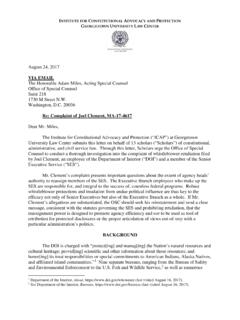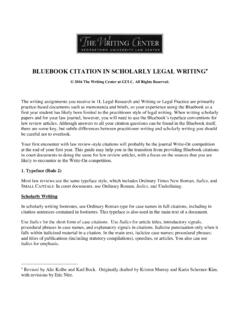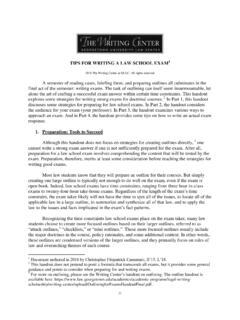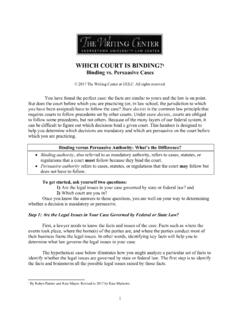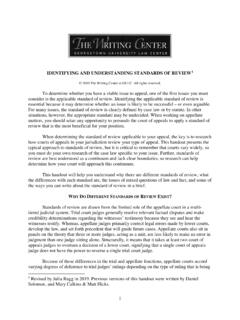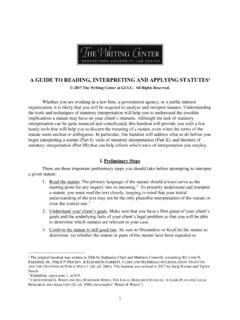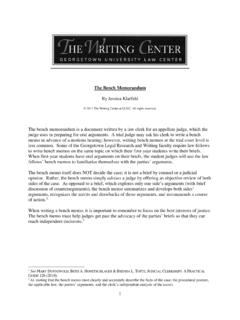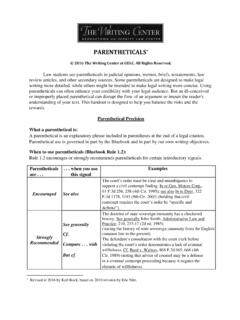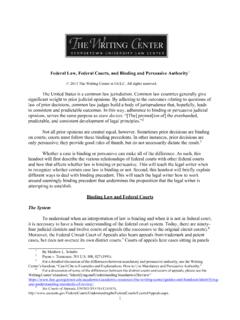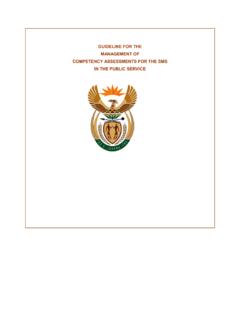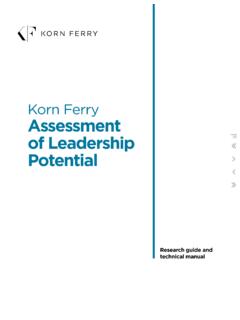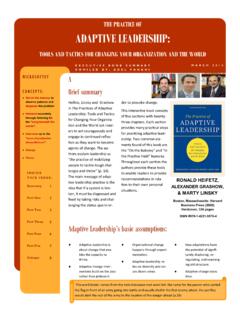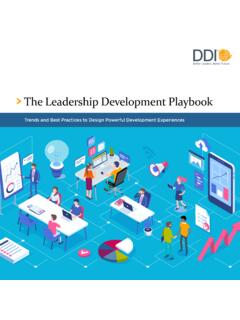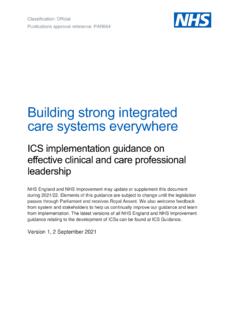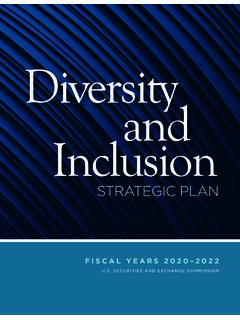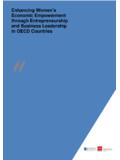Transcription of The Sexual Abuse To Prison Pipeline: The Girls’ Story
1 THE Sexual Abuse TO Prison pipeline : THE GIRLS Story Human Rights Project for Girls Georgetown Law Center on Poverty and Inequality Ms. Foundation for Women CENTER ON POVERTY and INEQUALITY authors of the report: Malika Saada Saar, Human Rights Project for Girls Rebecca Epstein, Georgetown Law Center on Poverty and Inequality Lindsay Rosenthal, Ms. Foundation for Women Yasmin Vafa, Human Rights Project for Girls The authors gratefully wish to acknowledge the following contributors for their substantive assistance to this report: Maheen Kaleem, Human Rights Project for Girls, who appeared at just the right moment, with unbending commitment and vision, to help bring us to the finish line. Julie F. Kay, Human Rights Attorney, whose human rights expertise, guidance and feedback immeasurably strengthened this report in service of America s most vulnerable girls.
2 Shakira Washington, Consultant, Human Rights Project for Girls, whose brilliant research and writing on girls at the margins laid the foundation for this paper s development. Teresa Younger, President of the Ms. Foundation for Women, whose leadership in supporting Ms. Fellow ship during her first months at the Foundation was essential to the completion of this report. And with thanks for their time and effort in reviewing this paper and providing invaluable insight: Mary Bissell, ChildFocus Peter Edelman, Georgetown Law Center on Poverty and Inequality Carmen Perez, Campaign for Youth Justice Liz Ryan, YouthFirst! Initiative Francine Sherman, Boston College Law School Dana Shoenberg, Center for Children s Law and Policy To obtain a hard copy of this report, please contact: Center for Poverty and Inequality | Georgetown University Law Center 600 New Jersey Avenue NW #461 Washington, DC 20001 | Download available at Design Ines Hilde, Georgetown Law Photography Front cover photo and photos on pages 4, 6, 27, and 34 by Richard Ross, Back cover photo and photos on pages 21 and 45 by Rebecca Epstein, All photos used by permission.
3 THE Sexual Abuse TO Prison pipeline : THE GIRLS Story Dedicated to the girls The Nature of This Flower Is to Bloom Rebellious. Living. Against the Elemental Crush. A Song of Color Blooming For Deserving Eyes. Blooming Gloriously For its Self. Alice Walker about the authors organizations Human Rights Project for Girls works to make the lives of US young women and girls a human rights priority. Gendered violence here in the US, like gendered violence abroad, restricts girls rights and the realization of their full potential and dignity. As a national organization of human rights lawyers, Rights4 Girls addresses the conditions of Sexual violence, rape, exploitation, and trafficking here in the United States in the areas of policy, legislation, and law.
4 We advocate for the dignity and personhood of young women and girls so that every girl may possess the right to be safe and live a life free of violence and exploitation. See more at The Center on Poverty and Inequality works with policymakers, researchers, practitioners, and advo cates to develop effective policies and practices that alleviate poverty and inequality in the United States. The Center s areas of anti-poverty work include national, state, and local policy and program recommen dations that help marginalized girls, promote effective workforce and education policies and programs for disconnected youth, and develop policy to combat deep poverty. Its strategies are to partner with Adminis tration agencies and non-profit organizations to host national conferences, produce and widely disseminate in-depth reports, engage in public speaking, and participate in national coalitions and working groups.
5 See more at The Ms. Foundation for Women is the first and largest US women s foundation. Since our founding in 1972, we have supported grassroots organizations across the country to sustain and amplify the vision and voice of women who area leading change in their communities, particularly low-income women, women of color and young women. We focus on three pillars women s health, economic justice and safety in order to fulfill our mission: to build women s collective power to realize a nation of justice for all. See more at Introduction 4 Girls Paths of Sexual Abuse into the Juvenile Justice System 6 The Proportion of Girls Especially Girls of Color in the Juvenile Justice System is Increasing.
6 7 Girls in the Juvenile Justice System are Disproportionately Victims of Sexual Violence. 7 Girls Behavioral Reaction to Sexual Abuse and Trauma is Criminalized, Reinforcing the Sexual Abuse to Prison pipeline . 9 The Juvenile Justice System Typically Fails to Address, and Often Exacerbates, Trauma that Caused Girls to Be There. 12 Dismantling the pipeline : Policy Recommendations to Reduce Traumatized Girls Arrest and Incarceration 15 Lived Experience of the Sexual Abuse to Prison pipeline : Victims of Sex Trafficking Jailed as Offenders. 19 Dismantling the pipeline : Policy Recommendations to Keep Victims of Sex Trafficking Out of Juvenile Justice 20 Lived Experience of the Sexual Abuse to Prison pipeline : Detention of Girls Who are Status Offenders.
7 22 Dismantling the pipeline : Policy Recommendations to Decrease the Disproportionate Effect of Status Offense Enforcement on Girls 23 In Focus: Dual-System Youth and the Sexual Abuse to Prison pipeline . 24 Dismantling the pipeline : Policy Recommendations to Reduce Foster Girls Crossing Over into the Juvenile Justice System 25 Child Welfare and the Sexual Abuse to Prison pipeline : Identifying and Treating Trauma in the Child Welfare System 27 Dismantling the pipeline : Policy Recommendations to Improve the Child Welfare System s Response to Girls 29 Conclusion 32 3 table of contents 4 VIOLENCE AGAINST GIRLS IS A PAINFULLY AMERICAN TALE. IT IS A CRISIS OF NATIONAL introduction Violence against girls is a painfully American tale.
8 It is a crisis of national proportions that cuts across every divide of race, class, and ethnicity. The facts are staggering: one in four American girls will experience some form of Sexual violence by the age of 18. Fifteen percent of Sexual assault and rape victims are under the age of 12;1 nearly half of all female rape survivors were victimized before the age of And girls between the ages of 16 and 19 are four times more likely than the general population to be victims of rape, attempted rape, or Sexual And in a perverse twist of justice, many girls who experience Sexual Abuse are routed into the juvenile justice system because of their victimization. Indeed, Sexual Abuse is one of the primary predictors of girls entry into the juvenile justice A particularly glaring example is when girls who are 5victims of sex trafficking are arrested on prostitution charges punished as perpetrators rather than served and supported as victims and survivors.
9 Once inside, girls encounter a system that is often ill-equipped to identify and treat the violence and trauma that lie at the root of victimized girls arrests. More harmful still is the significant risk that the punitive environ- ment will re-trigger girls trauma and even subject them to new incidents of Sexual victimization, which can exponentially compound the profound harms inflicted by the original Abuse . This is the girls Sexual Abuse to Prison pipeline . This report exposes the ways in which we criminalize girls especially girls of color who have been sexually and physically abused, and it offers policy recommendations to dismantle the Abuse to Prison pipeline . It illustrates the pipeline with examples, including the detention of girls who are victims of sex trafficking, girls who run away or become truant because of Abuse they experience, and girls who cross into juvenile justice from the child welfare system.
10 By illuminating both the problem and potential solutions, we hope to make the first step toward ending the cycle of victimization-to-imprisonment for marginalized girls. 6 GIRLS PATHS OF Sexual Abuse INTO THE JUVENILE JUSTICE SYSTEM girls paths of Sexual Abuse into the juvenile justice system7 girls paths of Sexual Abuse into the juvenile justice system the proportion of girls especiallygirls of color in the juvenile justicesystem is increasing. The rate of girls involvement in juvenile justice is growing disproportionately at key determinative points in the criminal justice process, including the decision to arrest and detain Girls of color are particularly affected by this Although rates of overrepresentation vary significant ly by jurisdiction,7 the national trends are revealing.
